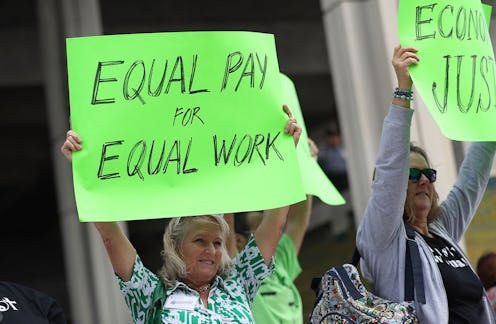News
The Gender Wage Gap Is Actually Way Bigger Than You Thought, A New Study Says

You may have heard the statistic that the average American woman takes home 80 cents for every dollar a white man earns, but that figure doesn't necessarily cover the full extent of the problem. A new study released this week found that the gender pay gap is much wider than previously estimated. In fact, looking at men's and women's earnings over a 15-year period shows that women actually make just 49 cents for every dollar men are paid — and the Institute for Women’s Policy Research (IWPR) says progress has slowed.
The commonly used figure that a woman earns 80 cents for every dollar earned by a man "understates the pay inequality problem by leaving many women workers out of the picture," the IWPR's new report says. By analyzing what workers are paid over a longer period, the researchers were able to account for women who took time off work to look after their families.
"Women’s earnings losses for time out are almost always greater than men’s," according to the study. Those losses are increasing, too; women who took one year off work between 2001 and 2015 saw their annual earnings drop 39 percent, while women in the '70s and '80s saw a loss of 12 percent.
Keep in mind that the wage gap is worse for black and Latina women than it is for white women. Previous estimates found that Latinas make 47 percent less than white men and black women make 38 percent less. While the IWPR doesn't break down its figures by race, its findings that the wage gap is getting wider for women who take time off work negatively impacts all women.
Because 43 percent of women in the workforce today have gone at least one year without a paycheck at some point (nearly twice the rate of men), the IWPR argues that closing the gender wage gap will require companies to better accommodate women workers. Paid family leave and affordable child care would make it easier for women to juggle their work and home lives, the study says, while better enforcement of equal employment opportunity policies would help shrink the wage gap.
"The failure of public policies to address the caregiving needs of both women and men leads to lower earnings for anyone who misses a year of work," IWPR wrote.
Yet the federal government has been slow to act when it comes to equal pay. Last year, the Trump administration rolled back an Obama-era rule that would have forced big companies to report how much they pay workers. The policy was intended to help close the gender way gap by creating more transparency, but it never went into effect.
And though presidential adviser Ivanka Trump has reportedly met with lawmakers to discuss establishing a national paid family leave plan, Congress has yet to make any real progress. The IWPR's new report highlights how much of a difference policies such as paid family leave could have on the gender wage gap, allowing women to "be treated fairly across their lifetimes."